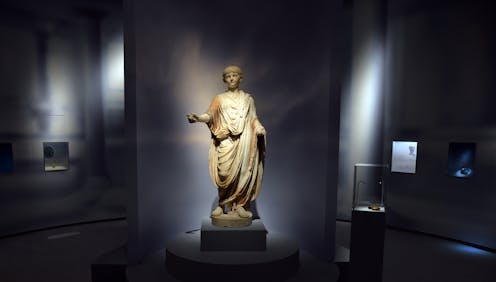Roman Empire and the fall of Nero offer possible lessons for Trump about the cost of self-isolation
Nero, Rome’s emperor from 54 to 68 C.E., rose to power at a young age and remained focused on himself, letting the needs of citizens fall to the wayside.

President Donald Trump’s first term saw a record-high rate of turnover among his Cabinet members and chief advisers. Trump’s second term has, to date, seen far fewer Cabinet departures.
But some political commentators have observed that the president this time around has primarily appointed loyal advisers who will not challenge him.
As Thomas Friedman pointed out in The New York Times on June 3, 2025, “In Trump I, the president surrounded himself with some people of weight who could act as buffers. In Trump II, he has surrounded himself only with sycophants who act like amplifiers.”
As a scholar of Greco-Roman antiquity, I have spent many years studying the demise of truth-telling in periods of political upheaval. Spanning the period from 27 B.C.E. to 476 C.E., the Roman Empire still offers insights into what happens to political leaders when they interpret possibly helpful advice as dissent.
Particularly telling is the case of Nero, Rome’s emperor from 54 to 68 C.E., who responded to a disastrous fire in 64 with extreme cruelty and self-worship that did nothing to help desperate citizens.
Suppressing honest advice under Nero
Rome’s first emperor, Augustus, established a handpicked circle of advisers – called the consilium principis in Latin, meaning emperor’s council – to give a republican look to his autocratic regime. Augustus became the emperor of Rome in 27 B.C.E. and ruled over the empire, which stretched from Europe and North Africa to the Middle East at its peak, until his death in 14 C.E.
Augustus wanted to hear what others thought about the empire’s needs and his policies. At least some of Augustus’ advisers were bold enough to assert themselves and risk incurring his displeasure. Some, such as Cornelius Gallus, paid for their boldness with their lives, Gallus apparently took his own life, so that might not be the best example – unless it was a forced suicide while others, such as Cilnius Maecenas, managed to push their political agendas in softer ways that allowed them to maintain their influence.
But the Roman emperors who came after Augustus were either less skilled at maintaining a republican facade, or less interested in doing so.
Nero was the last of the emperors from the noble Julio-Claudian dynasty in ancient Rome at its peak of power. Historians who describe Nero’s rise and fall from power describe the first five years of his reign, or the quinquennium neronis in Latin, as a period of relative calm and prosperity for the empire.
Because Nero was just 16 years old when he acceded to power, he was assigned advisers to guide his policies. Their opinions carried significant weight.
But five years into his reign, chafing at their continued oversight, Nero began to purge these advisers from his life, via execution, forced suicide and exile.
Nero instead collected a small cadre of self-interested enablers who derived power for themselves by encouraging their leader’s delusions, such as his desire to project himself as the incarnation of the sun god, Apollo.
The single most unspeakably corrupt and nefarious of these preferred advisers was Ofonius Tigellinus. Tigellinus had caught Nero’s eye early in 62 by urging the senate to convict a Roman magistrate of treason for having composed poems that he deemed insulting to the emperor. Later that year, Tigellinus was appointed the head of the emperor’s personal army.
As praetorian prefect, Tigellinus was charged not only with protecting Nero from physical harm, but also with crafting and guarding the leader’s public image. Tigellinus urged Nero to stage an ongoing series of public spectacles – like theatrical performances and athletic competitions – that featured him as a divine ruler and a god on Earth.

Up in flames
It was likely at Tigellinus’ urging that, in the aftermath of the great fire of 64 that raged for six days in Rome, Nero staged an exorbitant garden party where Christians were soaked in flammable oils and lit as human torches to illuminate a decadent late-night feast.
But, try as he might, Nero couldn’t outrun the fire and its aftermath by indulging in clever cruelties. Huge swathes of the city had been razed by the fire. Thousands of citizens lacked clothing. They were hungry, displaced and homeless.
For answers, the fire’s countless victims looked to Nero, their earthly Apollo, for help. But they did not encounter a sympathetic leader sweeping in to address their needs. Instead, they found a man desperate to place blame on others – in this case, foreigners from the east.
In order to squelch rumors that Nero had lit the fire, Tigellinus’ army unit rounded up Christians, falsely blamed them for starting the fire and executed them.
But this move just showcased Nero’s failure to focus on the dire needs of the poor, the very people who worshipped him. Instead, he sought to rise above the ashes by doubling down on his divine pretensions.
Once the rubble left by the fire was cleared away, Nero built a magnificent new home for himself. This palace, called the domus aurea in Latin, meaning house of gold, covered more than 120 acres in the heart of Rome. It featured spectacular water fountains, elaborate works of art and, standing tall in the entryway, a 120-foot bronze statue of Nero as the sun god, Apollo.
No truth-teller was there to tell Nero that maybe he shouldn’t rub his people’s noses in their suffering. (can we say ‘Maybe he shouldn’t exploit his people’s suffering in this way’?) this suggestion needs either accepted or rejected
Nero’s delusional response to the fire did not put an end to his career, but it did much to hasten its end.
Less than four years later, with armies bearing down on the city, Nero committed suicide. Rome tumbled into civil war.

Self-worship in the Trump era
Trump has long expressed a desire to have his face carved on Mount Rushmore, a national memorial in South Dakota that features the likenesses of legendary American presidents George Washington, Abraham Lincoln, Thomas Jefferson and Theodore Roosevelt.
This dream became a bit closer to reality when Tennessee Representative Andy Ogles in July 2025 urged the Department of the Interior to explore adding Trump’s image to Mount Rushmore – even though such an addition might not be possible because of geological issues.
Trump’s critics have long noted the president’s propensity to focus on himself and his own greatness and power, rather than the needs of citizens.
As far away as the Roman Empire might seem, Nero’s rise and fall offers a lesson in what can happen when honest criticism of a political leader is sidelined in favor of idolatry.
Instead of honest solutions to real problems, what Romans got was a colossal statue that portrayed their leader as a god on Earth.
Kirk Freudenburg does not work for, consult, own shares in or receive funding from any company or organization that would benefit from this article, and has disclosed no relevant affiliations beyond their academic appointment.
Read These Next
AI’s errors may be impossible to eliminate – what that means for its use in health care
Many health symptoms can be caused by multiple illnesses – if AI can’t tell the difference between…
AI-generated political videos are more about memes and money than persuading and deceiving
Don’t discount the threat of AI political videos fooling people, but for now, they’re mostly about…
Polytechnic universities focus on practical, career-oriented skills, offering an alternative to trad
Polytechnic universities try to incorporate skills-based learning into education.




